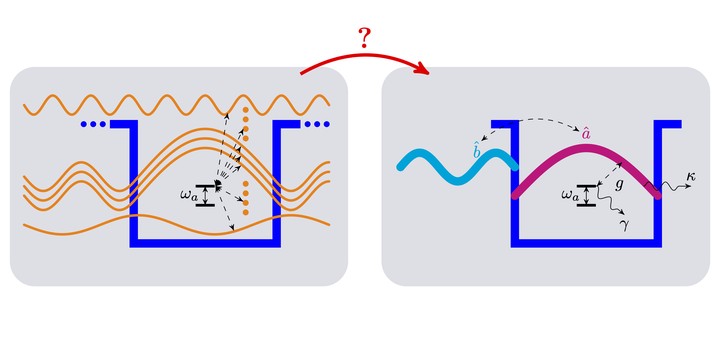Open quantum systems theory
 How to reduce a structured continuum to a few modes?
How to reduce a structured continuum to a few modes?
As most quantum optical systems, nuclear transitions and X-ray cavities are open by coupling to the environment. Interestingly, due to the extreme properties of the nuclei and the high photon energies, we are facing a number of theoretical challenges and open questions. As a result, I have been developing methods to describe the coupled quantum dynamics of X-rays and nuclei.
Historically, the methodology in nuclear resonant scattering has largely been based on semi-classical scattering theory. We are now extending these techniques to describe the full quantum dynamics by interfacing with quantum optical methods. Surprisingly, many of the theoretical questions are currently also being investigated in different fields in the optical domain. In this context, I have also been contributing to platform-independent theory development, using the slightly unusual X-ray perspective and insights from scattering theory.
As an example, we found that the established input-output formalism from cavity QED has its limitations for highly leaky and overlapping mode resonators, which we often encounter in the hard X-ray domain. Indeed, due to the high precision of the nuclear transitions, effects were observed experimentally [1] whose explanation required significant heuristic extensions to standard input-output theory [2]. Motivated by this observation, we developed an ab initio theory deriving the Hamiltonian that input-output theory is based on from first principles [a] and proving an equivalence to wave scattering theory. The result partially resolves a 30-year old question in theoretical quantum optics and provides an interesting approach to simplify continuum baths in general open quantum systems. In a recent paper [b], we applied the method to nuclear cavity QED, explaining the origin of previous discrepancies and discovering associated effects.
My current work is focussed on exploring new regimes of nuclear quantum dynamics using these methods.
External references
[1] R. Röhlsberger et al. Nature 482, 199–203 (2012)
[2] K. P. Heeg and J. Evers, Phys. Rev. A 91, 063803 (2015)
Related publications
[a] D. Lentrodt and J. Evers, Phys. Rev. X 10, 011008 (2020)
[b] D. Lentrodt et al. arXiv:2003.13859 (2020)